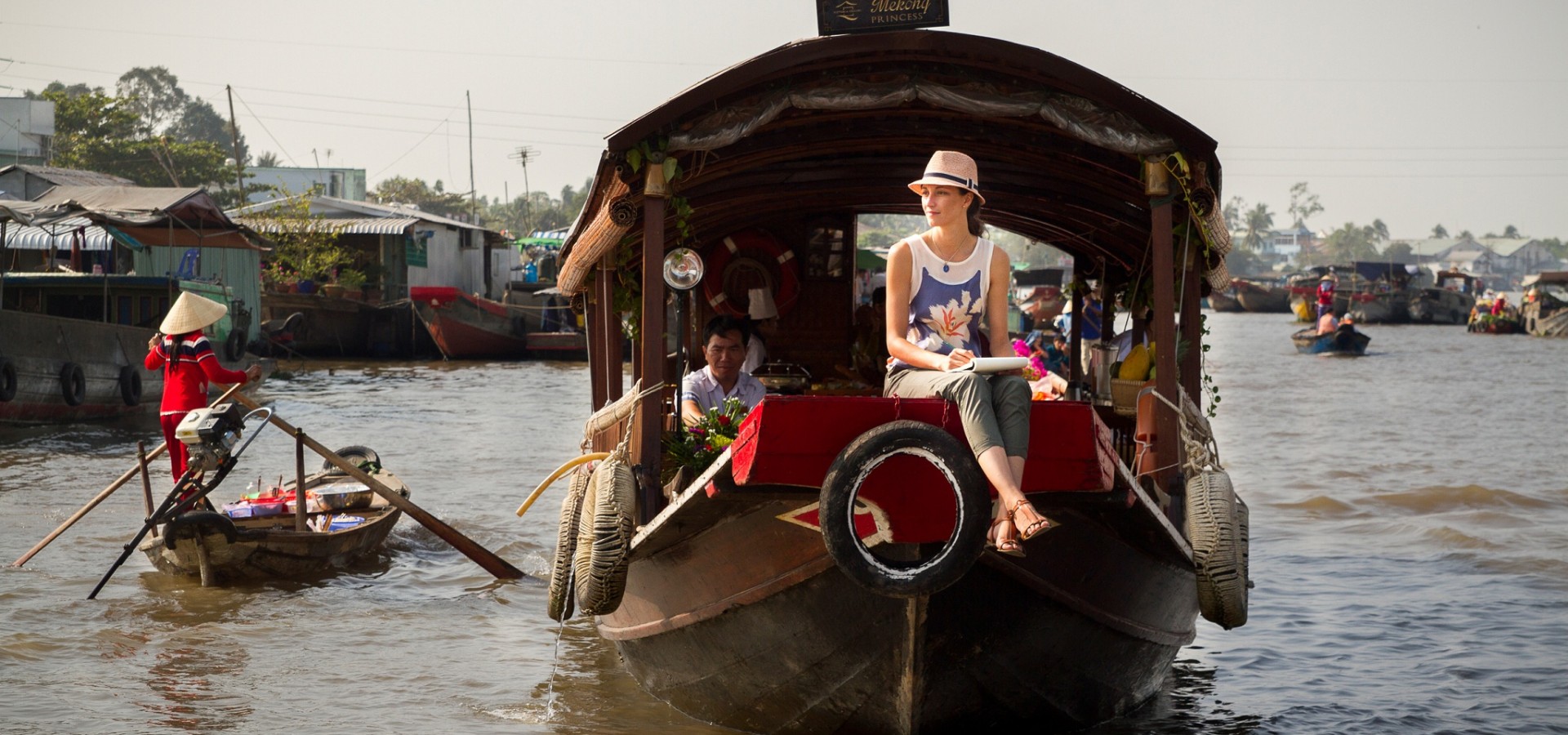Vietnam has up to 2.360 rivers with a total length of about 41.900 km. These form a dense network covering the whole country. Among them, a lot of the rivers, through the years, have witnessed many of the ups and downs of Vietnam history.
Nho Que River
Those conquering the Ma Pi Leng Pass in the northern upland province of Ha Giang shall be amazed by a river like a silky fillet in fog, as it brings them a pleasant sensation of a naturally romantic masterpiece. The river at the foot of Ma Pi Leng Pass is called Nho Que. A river concerned with the mysteries of nature.
A motorbike trip to Ma Pi Leng may be a wonderful way to discover the life in Northern Vietnam where life is still difficult and harsh. Ha Giang is one of the six poorest provinces of Vietnam but houses a lot of marvellous natural landscapes. Ma Pi Leng is one of the four highest passes in the country. It is not long, only 20km, but dangerous, with steep cliffs and deep mountainous slopes. Along with Ma Pi Leng Pass, Nho Que river is a legend, described in many poems and songs, and has become a symbol of Ha Giang. From the top of Ma Pi Leng, you can see Nho Que appearing like a blue thread thrown from the sky. The combination of the mighty Ma Pi Leng and the charming Nho Que is an unique beauty of Ha Giang. Originated in Yunnan of China, the length of the river in Vietnam is 46km; at an average altitude of 1,200m above sea level. Thanks to the advantage of an upper area with quite a slope, the river’s strong flow through rugged rock creates waterfalls in the middle of the valley. The river flows through Tu San canyon and Ma Pi Leng Pass of Meo Vac District. On both sides are high cliffs forming a deep and narrow canyon, with the murmur of Nho Que river flowing beneath. This brings an indescribable feeling, rejoicing in the immersion of a large space filled by sky and mountains. Nho Que brings a vital source of water for the whole plateau of Dong Van. There are 17 ethnic minorities who call the plateau home, living on cultivating rice along the basins of the Nho Que River and corn on the rocky mountain slopes. Life may be tough, but the local ethnic groups still keep their century-old traditions.
Ngo Dong River
Ngo Dong River is a small river in Ninh Hai Commune, Hoa Lu district, Ninh Binh province. Ngo Dong River flows from the lagoon valley in the heart of Trang An landscape complex, through the cliffs and rice paddies and then flows into Vac River system near Vung Tram Bridge. Ngo Dong River – the name itself brings a very romantic sentiment. Ngo Dong River meanders through a rural landscape, passing verdant rice paddies and jagged limestone formations. Ngo Dong is the way to travel to Tam Coc. From Tam Coc wharf in the village of Van Lam, it’s a two-hour trip along the river to the three limestone caves that give Tam Coc its name. Rowing a boat on the river at harvest time, seeing the golden colour of rice fields, surely makes an unforgettable memory in tourists’ mind.
Huong River
Huong (Perfume) River is a river that crosses the capital city of Hue, in the central Vietnamese province of Thua Thien Hue.
“A visit to Hue would not be complete without a boat excursion on the gentle Perfume River, or else you cannot feel the romance of Hue”. Many people associate the peaceful, elegant and beautiful scenery of Hue with Huong River. Together with the Huong River, Ngu Binh Mountain is also considered as the symbol of Hue – Hue is often known as the “Land of the Huong River and Ngu Mountain”. The travelers’ source of happiness when they sail along the river comes from the landscape and listen to the traditional Hue songs. The river is fragrant at a specific time of the year, in the autumn, when the flowers in the orchards up river lose their blossoms into the water.
Han River
Mentioning Da Nang, tourists cannot forget the poetic beauty of Han river and its bridge – the first swing bridge in Vietnam. The Han River flows through the central area of Da Nang and it has played an important part in the development of the city’s tourism sector. You have to see it to believe how Da Nang transforms into a city of light during the evening. As the night sets in, the colorful lights from skyscrapers, the bridges, restaurants and bars bring a completely different vibe to the city. Four colorful bridges cross the river and each one has a different silhouette, recently a large Sun-wheel was opened bringing even more light. All this makes Da Nang more vivid than ever. Just start your night with a stroll along the river banks where you’ll see both tourists and local people enjoy the cooler temperatures. All bridges crossing the Han River, which are illuminated by artistic LED lights, create a serene portrait of a city at night. Tourists can tour the award-winning Dragon Bridge in the shape of a dragon and witness it spit fire on Saturday and Sunday nights.
Cruising along the Han River at night or fishing on the rocks of Ngoc Islet off Hai Van Pass are becoming popular forms of summer entertainment in Da Nang.
Hoai River
Hoai River is a branch of the Thu Bon River flowing through the ancient town of Hoian. The small river running through the ancient town not only brings cool water steams but also sets up a stunning and poetic landscape.
For locals and tourists, this river is an inseparable symbol of the ancient town. In daytime, the river witnesses the daily life of locals and trading affairs as thousands of boats run along the stream and break the shades of clouds and trees over the water surface. When night comes, the river becomes a sparkling affair with colorful lanterns hanging over the nearby streets and on the boats. A day on the river usually starts very early in the morning because many tourists wish to see the sunrise on the river. At any time of the day, you can see small boats on the river. If you are ever lucky enough to come across the Hoai River in Hoi An you should then enjoy the pleasure of floating down the river of remembrance. Participating in a boat trip, tourists can admire the beauty of Hoi An from the water and listen to the interesting stories from ferryman. Also, many foreign tourists to the town now choose the bicycle tour from the river to Cua Dai Beach in order to admire the natural scenery as well as the life of locals.
Ben Hai River
Ben Hai River is one of the notable Vietnam rivers. It is the frontier boundary between North and South Vietnam, dividing the two countries between July 22, 1954, and April 29, 1975, when South Vietnam fell.
There is a famous bridge over Ben Hai River – Hien Luong Bridge, also called Peace Bridge built from steel by the French in 1950, which is painted in two colors with a white line down the middle. The North side is blue while the South is yellow. It is maintained as a major national monument for the reunification of Vietnam at the end of the Vietnam War. Nowadays, when you arrive in Quang Tri or in a DMZ zone trip, it is very pleasant to go on a boat down stream on the Ben Hai River and admire the beautiful landscapes.
Son River
Son River or Troc river is a branch of Gianh River in Quang Binh Province. The river leads to the entrance to Phong Nha Caves. A part of Son River flows underground in the limestone mountain range in the west of Quang Binh and in the heart of the Phong Nha – Ke Bang as well. Son River is associated with many legends, but the myth of faithfulness in love always impresses visitors. Son River is considered a pristine river, a beautiful landscape with which the Creator favorably blesses the locals. The river winding under the foothills embraces corn fields, banana gardens along with the peaceful neighborhood. On both sides of the river are serene landscapes. All harmonizing together creating a charming ink washed painting, a beautiful peaceful life among the immense mountainous region. This peaceful scenery is an appealing attraction in Quang Binh for tourists who love exploring the daily life and local people here.
Srepok River
Srepok River is a major tributary of the Mekong River. Flowing from the Central Highlands of Vietnam into northeastern Cambodia, the Srepok River is central to the lives and cultural identities of more than 11,000 people in Cambodia who live along the river. Coming from nine different ethnic groups, these riparian communities are largely dependent on fishing, lowland rice cultivation, and the collection of non-timber forest products for their livelihoods.
The river creates so many peaceful landscapes – particularly scenic waterfalls and streams such as Dray Nur, Dray Sap Falls, Virgin waterfall, Dray Nu, Dray H’linh, Gia Long (Dray Sap Thuong) waterfall… There are numerous fish specialties, especially hemibagrus and Bangana behri which are dedicated to kings. Srepok River finds its way through Yokdon National Park’s thick forest. Trekking through Yokdon forest is an unforgettable experience. The park runs all the way up to the border with Cambodia, with the beautiful Srekpok River. It is fortunate to see some Ede kids swimming or local people fishing along the stream enjoying a simply life there.
Mekong River
Mekong river is the longest in Southeast Asia. Fed by melt snow from the Tibetan plateau, the Mekong flows 4.350 km (2.700 miles) to the sea in South Vietnam. In Vietnam, it is called Cuu Long River (Nine Dragons River) for the nine branches of the Mekong Delta where land and water intertwine to make perfect conditions for growing rice.
Although it flows through six countries and feeds scores of people along the way, the Mekong is one of Asia’s least developed rivers. Thanks to the lack of industry along its banks, the Mekong teems with life – in fact, its biodiversity is second to that of the Amazon. Rich with wildlife and lined with everything from small towns to the stunning Angkor Wat temple complex, the Mekong’s many twists and turns have helped it retain its wild character.
The major river cruise lines offer a series of Mekong River trips in Vietnam and Cambodia, also Burma and Laos. Beyond the poverty, you’ll witness scenes of incredible beauty to delight the eye, from dazzling religious sites like the richly-detailed Angkor Wat and sunset-pink Banteay Srei to timeless glimpses of everyday life along the Mekong River. Unexpectedly uplifting, a trip on the Mekong offers a sense of the resilience of people who are remaking their lives, rebuilding cities destroyed by acts of war, and extending a warm welcome to visitors. Discover different countries, cultures and diverse ways of life for the vacation experience of a lifetime on the magnificent Mekong. Most Mekong river cruises come as part of long (two weeks or more) land tours, including several nights in hotels as well as overnights aboard ship, so consider the total package when choosing your cruise. If you want the cruise-only portion, look for a seven-night trip. The majority of Mekong River cruise tours start and end in Vietnam, beginning in Hanoi and ending in Ho Chi Minh City (Saigon) or vice versa. If it is important to you to see Halong Bay (the surreal seascape of limestone pillars located in the Gulf of Tonkin), some cruise lines offer Ha Long Bay as an extension to their cruise. When you cruise through the Mekong Delta, you can see the real rhythm of Vietnam: there you will find plenty of floating markets, orchards, and vast rice fields… Bangkok is another typical extension.
For most travelers, it takes several hours by air to get to Southeast Asia, so it makes sense to stay as long as you can and see as much as you can, budget and time permitting. Although cruise tours along the Mekong River are offered all year round, the most favourable time to go is from November through February; it’s cooler then and the rainy season which runs from July through October has passed.
Image Source: Internet




